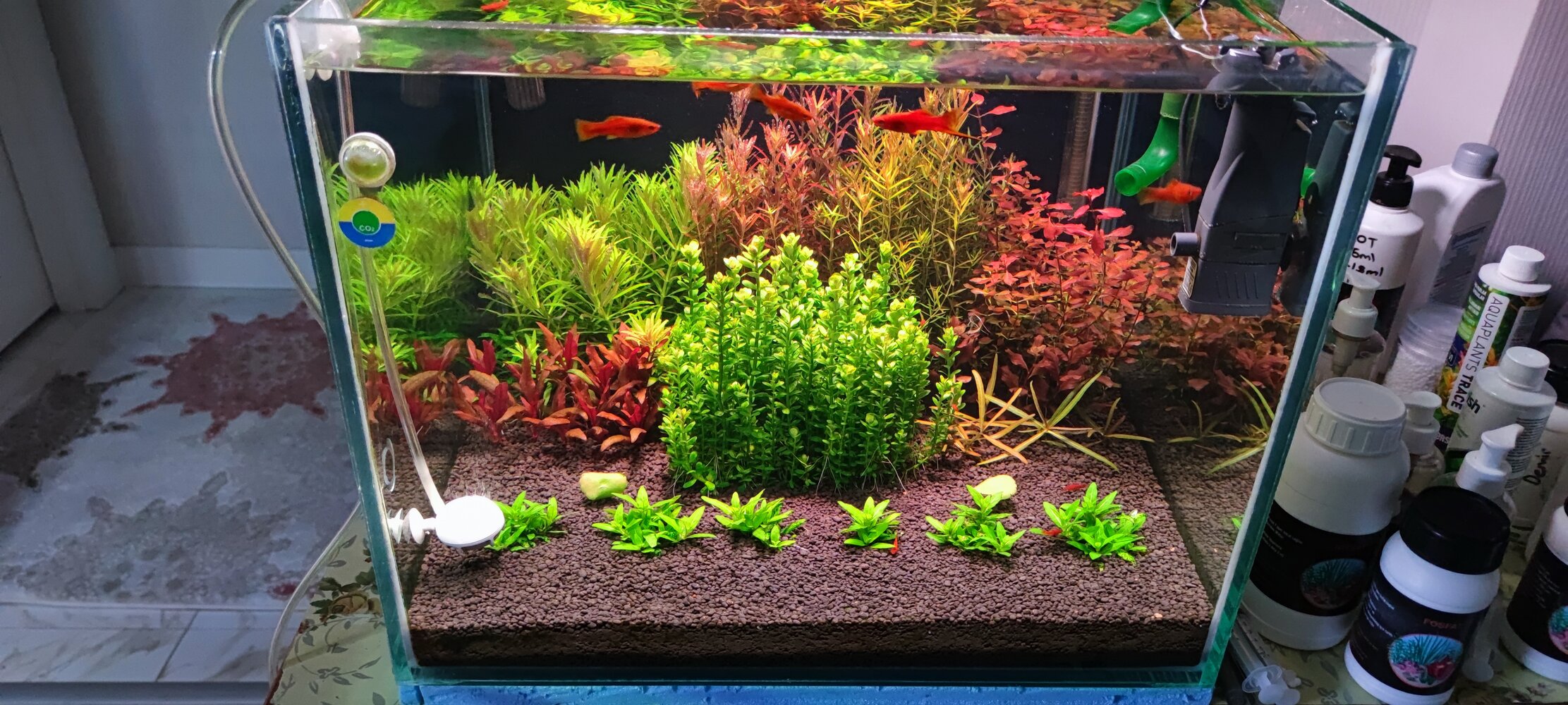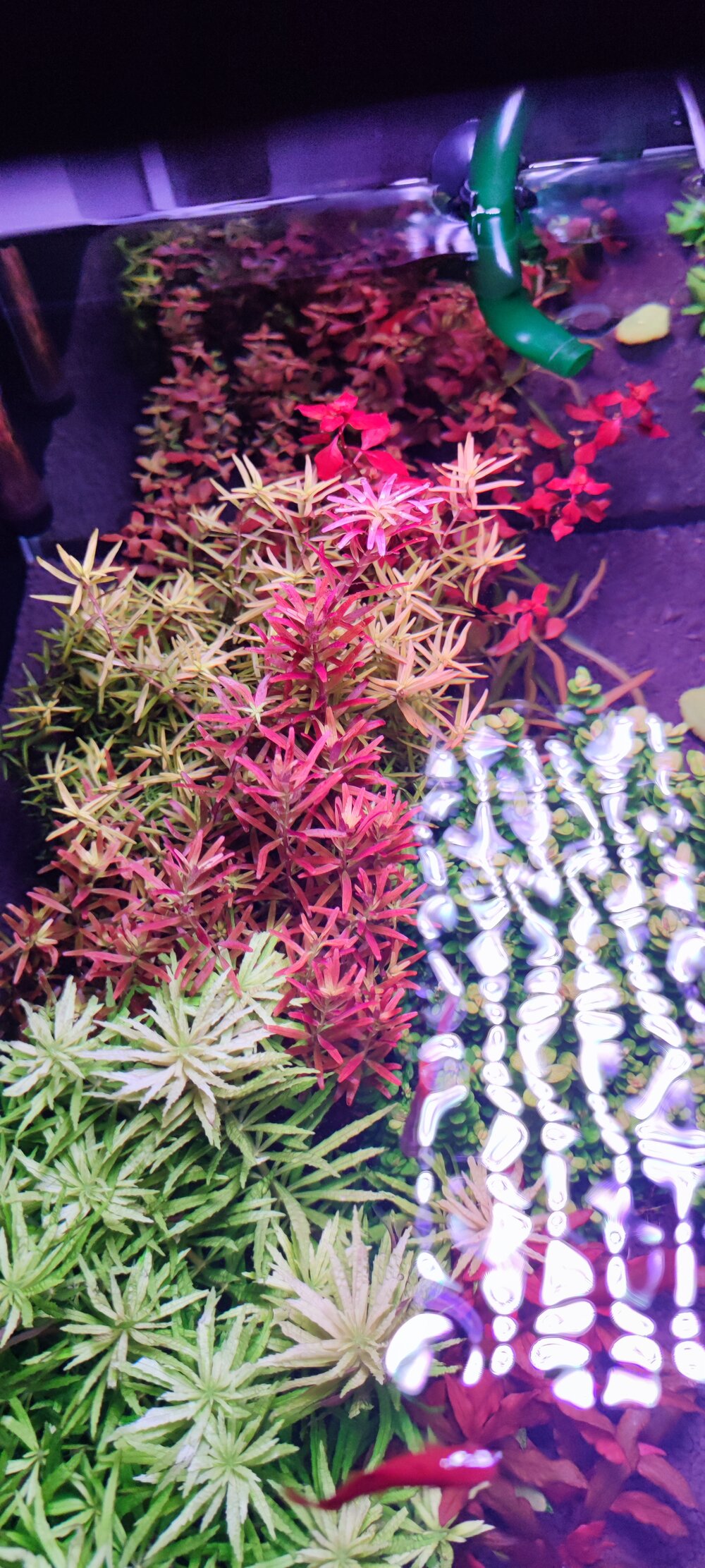Hi I opened a topic and the plants were losing color. I proved that this is caused by potassium nitrate. Now I use calcium ammonium nitrate and the colors of the plants started to improve. By the way, I reduced the potassium fertilizer. Only the potassium from ro mineral is 6ppm. I do not observe any potassium deficiency.
-
You are viewing the forum as a Guest, please login (you can use your Facebook, Twitter, Google or Microsoft account to login) or register using this link: Log in or Sign Up
You are using an out of date browser. It may not display this or other websites correctly.
You should upgrade or use an alternative browser.
You should upgrade or use an alternative browser.
KNO3 or calcium ammonium nitrate?
- Thread starter hasan66
- Start date
Hi all,
I would be pretty wary of the <"ammonia / ammonium (NH3 / NH4+) content"> for any one who has fish. The formula is 5Ca(NO3)2.NH4NO3.10H2O.
cheers Darrel
That should be all right. It will be interesting to see how you get on.Now I use calcium ammonium nitrate and the colors of the plants started to improve
I would be pretty wary of the <"ammonia / ammonium (NH3 / NH4+) content"> for any one who has fish. The formula is 5Ca(NO3)2.NH4NO3.10H2O.
cheers Darrel
I think seachem and tropica use nh4 and I have also seen people use these fertilizers in tanks with fish. I really don't know what makes ammonium so dangerous.Hi all,
That should be all right. It will be interesting to see how you get on.
I would be pretty wary of the <"ammonia / ammonium (NH3 / NH4+) content"> for any one who has fish. The formula is 5Ca(NO3)2.NH4NO3.10H2O.
cheers Darrel
X3NiTH
Member
- Joined
- 13 Apr 2014
- Messages
- 1,647
It’s the Un-Ionised form NH3 (Ammonia) that’s is most toxic.
Total ammonia in aqueous solution consists of two principal forms, the ammonium ion (NH4+) and un-ionised ammonia (NH3), with relative concentrations being pH- and temperature-dependent. The un-ionised form is most toxic due the fact that it is uncharged and lipid soluble and thus traverses biological membranes more readily than the charged and hydrated NH4+ ions (Wuhrmann and Woker, 1948, Downing and Merkens, 1955).

Total ammonia in aqueous solution consists of two principal forms, the ammonium ion (NH4+) and un-ionised ammonia (NH3), with relative concentrations being pH- and temperature-dependent. The un-ionised form is most toxic due the fact that it is uncharged and lipid soluble and thus traverses biological membranes more readily than the charged and hydrated NH4+ ions (Wuhrmann and Woker, 1948, Downing and Merkens, 1955).
The effect of pH variation at the ammonium/ammonia equilibrium in wastewater and its toxicity to Lemna gibba
_Maq_
Member
You're relatively safe as long as your pH is below 7.0.I really don't know what makes ammonium so dangerous.
pH 5.8 gave me cold water 😬 thank you my friendYou're relatively safe as long as your pH is below 7.0.
John q
Member
Well nothing was really proven, or dis proven. Certainly not in the context of the original post, which peeps should be aware of.I proved that this is caused by potassium nitrate
red plant color change
Hi friends, my Rotala blood red plant is red when the lights are first turned on, I look at it in the following hours, there is no trace of the color, what could be the reason?
www.ukaps.org
Seachem tend to opt for Urea, Tropica use some ammonium (NH4) blend.i think seachem and tropica use nh4
Either way I'm glad that within the space of a "few days" the problems of the tank seem to have been fixed, is the cure NH4, reduced potassium or something else?
MichaelJ
Member
Correct John, Tropica Specialized uses NH4NO3.Tropica use some ammonium (NH4) blend.
Cheers,
Michael
John, whenever I used potassium nitrate, I observed stunting in the plants and BGA in the leaves, but calcium ammonium nitrate did not cause such problems, from now on I will only use calcium nitrate or magnesium nitrate and see what happens.Well nothing was really proven, or dis proven. Certainly not in the context of the original post, which peeps should be aware of.
red plant color change
Hi friends, my Rotala blood red plant is red when the lights are first turned on, I look at it in the following hours, there is no trace of the color, what could be the reason?www.ukaps.org
Seachem tend to opt for Urea, Tropica use some ammonium (NH4) blend.
Either way I'm glad that within the space of a "few days" the problems of the tank seem to have been fixed, is the cure NH4, reduced potassium or something else?
_Maq_
Member
Well, all factors influence the outcome in their interactive complexity. You have changed one variable, and it brought positive results. But in different circumstances, the same action may lead to quite different outcome. This is because you don't take into account other variables.whenever I used potassium nitrate, I observed stunting in the plants and BGA in the leaves, but calcium ammonium nitrate did not cause such problems
Your experience suggests - and I stress the word 'suggests' - that there was too much potassium in your tank relative to calcium and magnesium. With the change of your fertilizer, you have improved the ratios of those three. Probably. We'd need reasonably precise measurements of all elements in question, and even then, it would only strongly suggest that this is the case. Such a scenario is in line with science, so it presents itself as a plausible explanation. However, it's still quite possible that yet other factors were at play in your case.
I'm studying these relations for years, and the more I know, the less I'm inclined to use the words "proof", "proved".
Sounds like a combination of nh4 and no3 to meWell nothing was really proven, or dis proven. Certainly not in the context of the original post, which peeps should be aware of.
red plant color change
Hi friends, my Rotala blood red plant is red when the lights are first turned on, I look at it in the following hours, there is no trace of the color, what could be the reason?www.ukaps.org
Seachem tend to opt for Urea, Tropica use some ammonium (NH4) blend.
Either way I'm glad that within the space of a "few days" the problems of the tank seem to have been fixed, is the cure NH4, reduced potassium or something else?
Hi all,
We know more about nitrification now than when that article was written and subsequently COMAMMOX Nitrospira have been found to be common in aquariums - <"Correspondence with Dr Ryan Newton - School of Freshwater Sciences, University of Wisconsin—Milwaukee">, but NO2- poisoning is still a risk.
cheers Darrel
the ammonium ion (NH4+) and un-ionised ammonia (NH3), with relative concentrations being pH- and temperature-dependent. The un-ionised form is most toxic due the fact that it is uncharged and lipid soluble and thus traverses biological membranes more readily than the charged and hydrated NH4+ ions
What @X3NiTH says, you also have the nitrite ion (NO2-) to consider <"Nitrite Toxicosis In Freshwater Fish or Brown Blood Disease">.I really don't know what makes ammonium so dangerous.
We know more about nitrification now than when that article was written and subsequently COMAMMOX Nitrospira have been found to be common in aquariums - <"Correspondence with Dr Ryan Newton - School of Freshwater Sciences, University of Wisconsin—Milwaukee">, but NO2- poisoning is still a risk.
I tend to use <"TAN (Total Ammoniacal Nitrate) as a concept"> rather than treating NH3 and NH4+ as separate entities. In low conductivity water pH is inherently unstable and depletion of CO2 can lead to rapid pH rise <"A question, dissolved oxygen and a pond"> and your "safe" NH4+ becomes NH3.pH 5.8 gave me cold water
cheers Darrel
Last edited:
On your original issue, did you add/increase remineralizer (Ca/Mg) or iron at any point? My plants go white like that without calcium/magnesium or iron. Excess potassium causes leaves to curl inwards. Excess nitrogen causes algae... also I'm not an expert on fish, but your type of fish need hard water, no?




